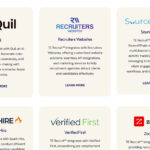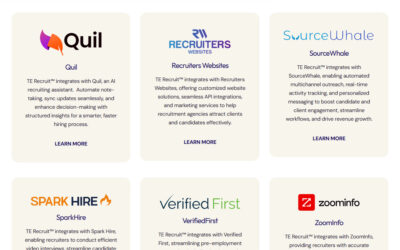Contract and temporary workers have become indispensable to the modern workforce, offering companies the flexibility to scale operations according to demand. From seasonal workloads to specialized projects, organizations increasingly rely on contract and temporary workers to fill critical gaps. To manage this dynamic form of hiring, many businesses turn to contract and temporary recruiting software.
This software simplifies the recruitment process, automates key tasks, and helps ensure compliance, making it easier for companies to attract, hire, and manage top talent efficiently.
In this expanded guide from Top Echelon Recruiting Software, we delve into the best practices for utilizing contract and temporary recruiting software, highlighting how these tools can optimize your hiring process and enhance workforce management.
1. Define Your Needs
Before implementing contract and temporary recruiting software, it’s essential to clearly define your hiring needs. This step lays the foundation for a successful recruitment strategy by identifying the type of work to be performed, the skills required, and the duration of the assignments.
Assess the Scope and Type of Work
Understanding the specific nature of the work involved is crucial. Are you looking to fill short-term positions for seasonal spikes in demand, or do you need highly skilled contractors for specialized projects? Clarifying the scope helps you target the right candidates and set appropriate expectations.
Determine Skill Requirements
Defining the skills and qualifications needed for each position allows you to tailor your sourcing strategy. Whether it’s technical expertise, project management skills, or customer service experience, specifying these criteria ensures that you attract candidates who are well-suited to the job.
Outline Contract Length and Work Arrangements
Knowing the expected duration and work arrangements, such as remote, hybrid, or on-site work, will influence your candidate pool. Clearly outlining these details helps avoid misunderstandings and ensures that candidates are fully aware of the terms before applying.
Identify Software Features Needed
Once your needs are defined, consider the software features that will best support your recruitment goals. For instance, if you need to hire quickly, look for platforms with automated sourcing and screening tools. If compliance is a top priority, focus on software with robust document management and auditing capabilities.
A comprehensive understanding of your requirements will guide your selection of recruiting software, ensuring it aligns with your business objectives.
2. Automate Sourcing and Screening
One of the most significant advantages of contract and temporary recruiting software is the ability to automate sourcing and screening processes. These features not only save time but also enhance the quality of your candidate pool by efficiently filtering out unqualified applicants.
Job Posting Automation
Recruiting software can automate job postings across multiple platforms, including job boards, social media, and your company’s career page. This wide distribution increases visibility and attracts a broader range of candidates. By utilizing templates and pre-set criteria, you can ensure consistency and accuracy in your job advertisements.
Resume Screening Tools
Automated resume screening tools leverage artificial intelligence (AI) to evaluate candidates against your predefined criteria. These tools can assess skills, experience, and qualifications, helping you quickly identify the most suitable candidates. Advanced platforms can even rank candidates based on how well they match the job requirements, streamlining the selection process.
Integration with Third-Party Job Boards
Many contract and temporary recruiting software platforms integrate with third-party job boards, recruiting agencies, and talent marketplaces. This connectivity allows you to tap into a vast network of potential candidates, expanding your reach and increasing the likelihood of finding the right fit.
By automating sourcing and screening, you can significantly reduce the time-to-hire and focus your efforts on engaging with the most promising candidates.
3. Use a Centralized Database
A centralized database is a critical component of effective contract and temporary workforce management. It serves as a comprehensive repository of candidate information, allowing you to track work history, skills, certifications, and performance metrics.
Benefits of a Centralized Database
- Easy Access to Candidate Information: With a centralized database, all candidate information is stored in one place, making it easy to retrieve and review details about previous hires. This feature is particularly useful when re-engaging past contractors for new assignments.
- Performance Tracking: Keeping detailed records of each worker’s performance helps you identify high performers who may be suitable for future projects. Performance data can include metrics such as project completion rates, quality of work, and feedback from supervisors.
- Skill Matching for Future Assignments: A well-maintained database allows you to quickly match candidates with relevant assignments based on their skills and experience. This capability can save time during periods of high demand when you need to fill positions rapidly.
Having a centralized database not only improves organization but also enhances decision-making by providing valuable insights into your contract and temporary workforce.
4. Streamline the Hiring Process
The hiring process for contract and temporary workers often involves multiple stakeholders, including hiring managers, recruiters, and staffing agencies. Contract and temporary recruiting software can streamline this process by providing end-to-end workflows and tools that facilitate each step.
Workflow Automation
Automated workflows guide recruiters through the hiring process, ensuring that each step is completed efficiently. From initial candidate screening to onboarding, these workflows reduce administrative burdens and keep the hiring process on track.
Digital Signatures and Contract Management
Digital signatures and contract management tools eliminate the need for physical paperwork, speeding up the hiring process. These features enable candidates to sign contracts electronically, making the process faster, more secure, and environmentally friendly.
Payment Processing
Contract and temporary recruiting software often includes integrated payment processing features, allowing you to manage invoicing and payments directly within the platform. This functionality ensures that workers are paid promptly and accurately, fostering a positive relationship with your temporary workforce.
By streamlining the hiring process, you can reduce time-to-hire, minimize errors, and enhance the overall candidate experience.
5. Ensure Compliance
Compliance is a critical concern when managing contract and temporary workers, as these arrangements often involve complex legal and regulatory requirements. Contract and temporary recruiting software helps mitigate compliance risks by providing built-in features that support regulatory adherence.
Automated Onboarding
Automated onboarding processes guide new hires through necessary compliance steps, such as filling out tax forms, submitting identification documents, and completing safety training. This automation ensures that all required information is collected and verified before work begins.
Document Management and Audit Trails
Recruiting software often includes document management systems that store essential compliance documents, such as contracts, tax forms, and certifications. Audit trails track changes and updates, providing a clear record of compliance activities that can be useful during internal reviews or external audits.
Regulation Adherence
Depending on the nature of the work, contract and temporary positions may be subject to industry-specific regulations, such as labor laws, data privacy requirements, and safety standards. Recruiting software can help ensure compliance by automatically updating processes to reflect the latest legal requirements and alerting users to any changes.
Ensuring compliance not only protects your organization from legal risks but also builds trust with your workforce by demonstrating a commitment to fair and lawful practices.
6. Monitor and Evaluate Performance
To maintain a high-performing temporary workforce, it’s essential to continuously monitor and evaluate performance. Contract and temporary recruiting software provides tools that enable you to track key performance metrics, offering insights that can guide future hiring decisions.
Performance Metrics Tracking
Performance metrics such as quality of work, adherence to deadlines, and productivity levels can be tracked within the software. This data allows you to assess the effectiveness of your workers and identify areas for improvement.
Feedback and Reviews
Incorporating feedback mechanisms within the software enables you to gather input from managers and team members regarding a worker’s performance. This feedback can inform decisions about whether to extend a contract, offer additional training, or consider a candidate for future assignments.
Data-Driven Decisions
By analyzing performance data, you can make informed decisions about which workers to rehire and which processes need adjustment. This approach helps you maintain a high standard of work and ensures that your temporary workforce contributes positively to your organization’s goals.
Effective performance monitoring supports continuous improvement and helps build a reliable pool of contract and temporary talent.
7. Foster Strong Relationships with Staffing Agencies
Staffing agencies play a pivotal role in the contract and temporary hiring landscape, often acting as intermediaries between companies and candidates. Building strong relationships with these agencies can enhance your recruiting efforts and ensure that you receive high-quality candidates.
Clear Communication
Establish clear lines of communication with staffing agencies, outlining your expectations, hiring criteria, and feedback processes. Regular communication helps align efforts and ensures that the agencies understand your specific needs.
Set Expectations
Clearly define the performance standards and compliance requirements for temporary workers provided by staffing agencies. Setting these expectations upfront helps prevent misunderstandings and ensures that candidates meet your organization’s standards.
Provide Feedback
Offering feedback to staffing agencies about the performance of their candidates helps improve future placements. Constructive feedback allows agencies to better understand your needs and refine their sourcing strategies accordingly.
Fostering collaborative relationships with staffing agencies enhances the effectiveness of your recruiting software and helps create a seamless hiring experience.
8. Integrate with Other Systems
Contract and temporary recruiting software often functions as part of a broader HR ecosystem. Integrating this software with other HR tools, such as payroll, time tracking, and HR management systems, maximizes its value and ensures seamless data flow.
Enhanced Data Accuracy
Integration helps maintain data consistency across all platforms, reducing errors and ensuring that information such as employee details, payment records, and compliance documents are always up-to-date.
Streamlined Payroll
By connecting recruiting software with payroll systems, you can automate payment processing, ensuring that contract and temporary workers are paid accurately and on time. This integration reduces administrative burdens and minimizes the risk of payroll errors.
Unified Reporting
Integrated systems provide a holistic view of your workforce, allowing you to generate comprehensive reports that combine data from multiple sources. This unified approach supports strategic decision-making and provides deeper insights into workforce trends.
Effective integration streamlines operations, enhances data accuracy, and contributes to a more cohesive HR strategy.
Contract and temporary recruiting software is a powerful tool for managing the dynamic needs of today’s workforce. By defining your needs, automating sourcing and screening, using a centralized database, streamlining the hiring process, ensuring compliance, monitoring performance, fostering relationships with staffing agencies, and integrating with other systems, organizations can optimize their contract and temporary hiring efforts.
Ultimately, leveraging these best practices enables companies to improve productivity, control costs, and adapt quickly to changing business needs, all while maintaining a high standard of workforce management. As the reliance on contract and temporary workers continues to grow, investing in robust recruiting software and following these strategies will position your organization for sustained success.








